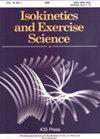在往复等速肌肉动作过程中,共激活不会导致疲劳引起的扭矩下降
IF 0.6
4区 医学
Q4 ENGINEERING, BIOMEDICAL
引用次数: 2
摘要
背景:共激活的研究通常使用单运动等速或等速疲劳肌肉动作。目的:本研究的目的是研究男性前臂屈肌和伸肌在慢(60°/秒)和中(180°/秒)等速运动时,肱二头肌(BB)和肱三头肌(TB)对最大、互反等速疲劳的反应。方法:10名男性(平均±SD:年龄= 21.6±1.3岁)在60和180度/秒的情况下完成50个连续的、最大的、反向的、等速的右前臂屈肌和伸肌动作。在整个疲劳过程中同时记录BB和TB肌电图(EMG)和肌力图(MMG)信号的振幅(AMP)和平均工频(MPF)含量。采用重复测量方差分析(anova)和Tukey post hos来确定重复的扭矩和神经肌肉参数的平均差异。结果:扭矩分析表明,180°/s时的疲劳程度比60°/s时更大(p= 0.02)。在60°/s的弯曲或伸展时,肌电图AMP均无显著变化(p < 0.05)。在180°/s时,激动剂肌电信号AMP显著增加(p= 0.01至0.004),而拮抗剂肌电信号AMP没有变化(p= 0.05)。肌电强磁共振显示,在两种速度下,屈曲和伸展期间(p< 0.001至p= 0.02),肌肉塌陷时均有显著下降。MMG、AMP和MPF在重复中无显著变化(p> 0.05)。结论:这项研究显示了对疲劳的速度特异性反应,在180°/秒时的疲劳程度更大。此外,尽管激动剂肌肉在180°/s时肌电AMP增加,但这不足以改变共激活的比例,可能是由于肌肉之间有共同的神经驱动。因此,在目前的研究中,扭矩的减少不能归因于共激活的增加。本文章由计算机程序翻译,如有差异,请以英文原文为准。
Coactivation does not contribute to fatigue-induced decreases in torque during reciprocal, isokinetic muscle actions
BACKGROUND: Studies of coactivation have typically utilized single movement isometric or isokinetic fatiguing muscle actions. OBJECTIVE: The purpose of the current study was to examine coactivation of the biceps brachii (BB) and triceps brachii (TB) in response to a maximal, reciprocal, isokinetic fatiguing task of the forearm flexors and extensors at slow (60∘/s) and moderate (180∘/s) isokinetic velocities in men. METHODS: Ten men (mean ± SD: age = 21.6 ± 1.3 years) completed 50 consecutive, maximal, reciprocal, isokinetic muscle actions of the right forearm flexors and extensors at 60 and 180∘/s. The amplitude (AMP) and mean power frequency (MPF) contents of the electromyographic (EMG) and mechanomyographic (MMG) signals from the BB and TB were recorded simultaneously throughout the fatiguing task. Repeated measures ANOVAs with Tukey post hocs were used to determine mean differences for the torque and neuromuscular parameters across repetitions. RESULTS: The torque analyses indicated greater fatigability at 180∘/s, compared to 60∘/s (p= 0.02). There were no significant changes in EMG AMP for either muscle during flexion or extension at 60∘/s (p> 0.05). At 180∘/s, there were significant increases in agonist EMG AMP (p= 0.01 to 0.004), however, no changes in antagonist EMG AMP (p> 0.05). For EMG MPF, there were significant decreases during flexion and extension (p< 0.001 to p= 0.02) at both velocities, collapsed across Muscle. There were no significant (p> 0.05) changes across repetition for MMG AMP or MPF. CONCLUSIONS: This study indicated velocity-specific responses to fatigue, with a greater magnitude of fatigability at 180∘/s. Furthermore, despite increases in EMG AMP of the agonist muscles at 180∘/s only, it was not sufficient to alter the ratio of coactivation, likely due to common neural drive between muscles. Thus, the decreases in torque in the present study were not attributable to increases in coactivation.
求助全文
通过发布文献求助,成功后即可免费获取论文全文。
去求助
来源期刊

Isokinetics and Exercise Science
医学-工程:生物医学
CiteScore
1.20
自引率
14.30%
发文量
37
审稿时长
>12 weeks
期刊介绍:
Isokinetics and Exercise Science (IES) is an international journal devoted to the study of theoretical and applied aspects of human muscle performance. Since isokinetic dynamometry constitutes the major tool in this area, the journal takes a particular interest in exploring the considerable potential of this technology.
IES publishes studies associated with the methodology of muscle performance especially with respect to the issues of reproducibility and validity of testing, description of normal and pathological mechanical parameters which are derivable from muscle testing, applications in basic research topics such as motor learning paradigms and electromyography. The journal also publishes studies on applications in clinical settings and technical aspects of the various measurement systems employed in human muscle performance research.
The journal welcomes submissions in the form of research papers, reviews, case studies and technical reports from professionals in the fields of sports medicine, orthopaedic and neurological rehabilitation and exercise physiology.
 求助内容:
求助内容: 应助结果提醒方式:
应助结果提醒方式:


